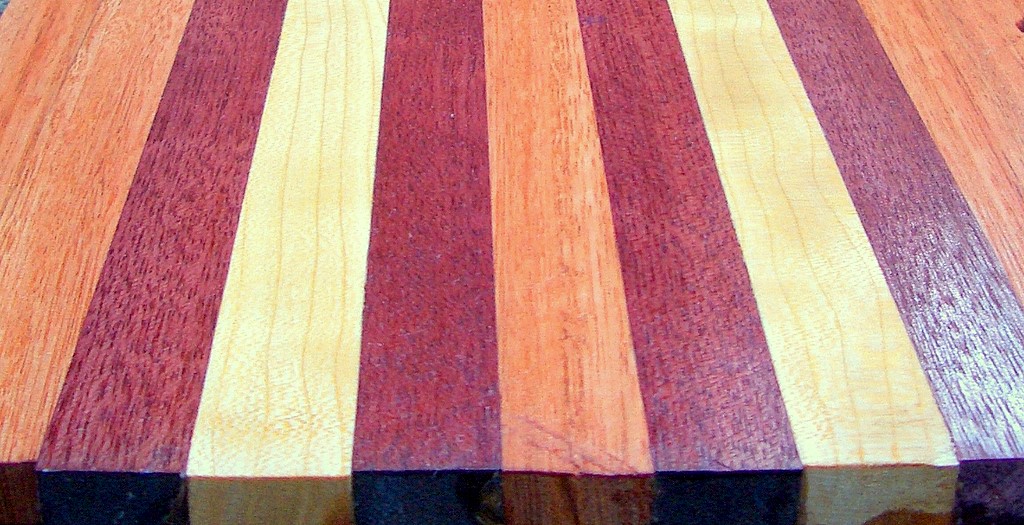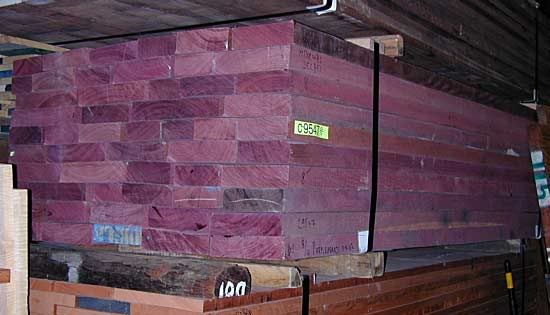When I say the word ‘wood’ to you, you probably think of the stuff that trees are made of (obviously) and a color that runs somewhere in the pale (maple), brownish (oak) or dark (walnut) category.
Some logs, however, can really surprise you with their dramatic colors. Purpleheart is a striking example of just how unique the natural color of wood can be.

This South American hardwood grows in the rain forests of Brazil, Guyana and Suriname. “When the stuff is first cut, the boards are very plain looking – kind of a light tan,” said Eric Proirier of Bell Forest Products. “But, once they are exposed to the air, they take on a vibrant purple color. It’s an amazing transformation.” But, Eric warns, if you want to keep the bright purple, you are going to have to put a UV blocking finish on it. “If you don’t, eventually the wood will change to a darker brown color with just a hint of the purple in it. Still nice looking, but nothing like what you started with.”
Since it is harvested from the tropical rain forests, there is a concern about over harvesting. “There have been some cases of that in the past, but we have made a commitment to buy our logs from environmentally-responsible loggers. For something as dramatic as purpleheart, we want to ensure that future generations of woodworkers will be able to work with it.”

Purpleheart is also legendary for its hardness. In the Janka test (how much force it takes to push a steel ball halfway into the wood), purpleheart rates at 1860 pounds of force. “That’s more durable than North American hickory… it’s pretty strong stuff!” Very sharp tools are the keys to successfully working with this tough wood. “Keep your chisels and planes honed, and be sure to use carbide on your power tool bits and blades. Other than that, it’s a very well-behaved wood that works well.”
What can you do with Purpleheart? The unique color makes it a natural accent for lighter woods. Dovetail keys and splines to reinforce a corner are naturals, and it makes outstanding cabinet knobs and pulls. “An inlay or stringing done in purpleheart is eye-catching especially on a maple or birch table top. People who see your work will ask how you stained the wood to look like that.”

Since the wood is also very hard and durable, it’s a natural for making the bodies of wooden planes. “You can’t dent the stuff with a fingernail, making it ideal for plane makers. Even if you just wanted to laminate a purpleheart sole onto another material for the plane body, that would give you the durability you need to make a long lived tool.”
Its tough nature and shock resistance makes it a great pool cue material, and Bell Forest Products keeps a number of pool cue blanks on hand for that purpose.

It also excels in the kitchen. “We have put together a kit of the wood necessary to make a Wood Whisperer cutting board containing maple and purple heart. Even if your culinary skills aren’t all that good, the cutting board you use will dazzle your guests!”

Speaking of kitchen applications, I have a nice piece of purpleheart that is destined to become the handle of a potato masher – a custom Christmas gift
looking for very highly figured purpleheart poss. quilted, or very curly
1′ x 6′ x 18′ & 2′ x2′ x 41′ thanks
Bell Forest Products has a great selection…. look them up at http://www.bellforestproducts.com.